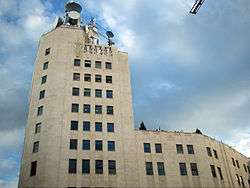Bucharest Telephone Palace
Bucharest Telephone Palace (Romanian: Palatul Telefoanelor) is an office building located on Calea Victoriei in Bucharest, Romania. It is now owned by Telekom România.
Bucharest


Palatul Telefoanelor in Bucharest is an art deco style building and until 1956, was the tallest building in Bucharest at 52.5 meters. [1]
The Great Depression that began with the Wall Street Crash of 1929 strongly impacted the Romanian economy. The Romanian government decided to take a loan from the American trust, Morgan, which obtained from this transaction the granting of a 20-year monopoly on Romanian telephony to the International Telephone and Telegraph Corporation (ITT),[2] which then formed the Societatea Anonimă Română de Telefoane (SART, "Romanian Telephone Company, Ltd.").[3] The aim was to modernize Romanian telephony and to construct the Telephone Palace.[4]
Designed on behalf of SART by the Romanian architect of Dutch origin Edmond Van Saanen Algi and built over the course of about 20 months in 1931–1933, it was the first major modernist building on Bucharest's Calea Victoriei,[5] the street of which Tudor Octavian wrote, "this is how the whole of Bucharest would look if we had been allowed…, if its builders had been clever enough…"[6] It was constructed on the former site of the Otetelesanu Mansion, which had been, since the turn of the century, home to a terrace bar (Terasa Otetelesanu), a coffee house and a beer saloon, competing with Casa Capșa for the custom of Bucharest's elite from its location next to the old Romanian National Theatre.[7]

The steel skeleton was produced by the steelworks at Reşiţa. The building was inaugurated in 1934 in the presence of King Carol II.[8] The building was extended (both vertically and horizontally) in 1940 and 1946, and survived earthquakes in 1940, 1977, 1986 and 1990 and bombing in 1944 by Allied Forces during World War II.[9] With the advent of the Communist era, the building passed into the hands of the Romanian government, along with SART itself, which was nationalized as a division of the Ministry of Posts and Telecommunications. The 1989 Revolution resulted in the establishment of the independent ROM-POST-TELECOM, reorganized as Romtelecom in July 1991.[10]
A 1993 study revealed structural problems (the roof was never designed to support microwave antennas, but only a coffee shop); before a major reconstruction project could be started in 1997, engineers had to begin by redrawing building plans, as the originals had been lost. Works included reconstruction to duplicate the original façade, as well as structural reinforcement. The reconstruction design was made by Romanian architecture office Proiect Bucuresti. The whole Project, which ultimately employed 700 people, was the largest architectural reconstruction project ever undertaken in Romania.[11] It cost roughly €1 million, and lasted until 2005.[12]
Notes
- ↑ Construcții; "List of Names and Places Explained: The Telephone Palace" in Bucharest Between the Wars for date it ceased to be tallest.
- ↑ "List of Names and Places Explained".
- ↑ Romtelecom.
- ↑ "List of Names and Places Explained".
- ↑ Romtelecom, Construcții. "List of Names and Places Explained" says the architects were the Americans Louis Weeks and Walter Froy.
- ↑ Bucureștiul Interbelic, p. 5 (pages unnumbered).
- ↑ "List of Names and Places Explained", section cited and "The Otetelesanu Mansion"; Anghel, "Cum se distrau…"
- ↑ "List of Names and Places Explained".
- ↑ Romtelecom, Rotary Construcții; Kaufmann 2001 for the earthquake dates.
- ↑ "Romtelecom - History and Tradition". Archived from the original on 2005-12-01. Retrieved 2006-05-22.
- ↑ Romtelecom, Rotary Construcții.
- ↑ Nuta 2005.
References
- Adrian Nuta, Dupa zece ani de renovare, Palatul Telefoanelor are o noua faţa ("After then years of renovation, the Telephone Palace has a new face"), Averea, 13 May 2005, accessed 2 January 2006.
- Kaufmann, Birgit, Earthquake Exposure In Romania, Exposure, issue No. 5, February 2001, accessed 2 January 2006.
- Consolidarea Palatului Telefoanelor, Rotary Construcții, 2004, accessed 2 January 2006.
- The Telephone Palace in Bucharest, "Advertorial" on the site of Romtelecom, accessed 2 January 2006.
- —, Bucureștiul Interbelic/Calea Victoriei/Interbellum Bucharest, NOI Media Print, ISBN 973-99493-7-1
- List of Names and Places Explained: The Telephone Palace, in Bucharest Between the Wars: A Modernity With Fringes, Romanian Academy Library, accessed 4 January 2006.
- Dinu Anghel, Cum se distrau romanii vara, acum un veac "How Romanians spent summer a century ago", reprinted from Bucătăria pentru toti, accessed 4 January 2006.
External links
- Calea Victoriei between Casa Capşa and Palatul Telefoanelor, 1935, photo.
- Photo of Palatul Telefoanelor after reconstruction.
Coordinates: 44°26′10.66″N 26°5′51.24″E / 44.4362944°N 26.0975667°E